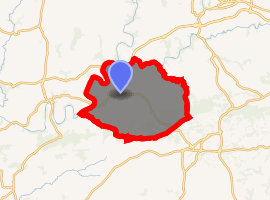Spézet
Spézet (Breton: Speied) is a commune in the Finistère department of Brittany in north-western France.
Spézet Speied | |
|---|---|
_Mairie.jpg) The town hall in Spézet | |
.svg.png) Coat of arms | |
Location of Spézet 
| |
 Spézet  Spézet | |
| Coordinates: 48°11′34″N 3°42′55″W | |
| Country | France |
| Region | Brittany |
| Department | Finistère |
| Arrondissement | Châteaulin |
| Canton | Carhaix-Plouguer |
| Intercommunality | Haute Cornouaille |
| Government | |
| • Mayor (2014–2020) | Gilbert Nigen |
| Area 1 | 60.67 km2 (23.42 sq mi) |
| Population (2017-01-01)[1] | 1,808 |
| • Density | 30/km2 (77/sq mi) |
| Time zone | UTC+01:00 (CET) |
| • Summer (DST) | UTC+02:00 (CEST) |
| INSEE/Postal code | 29278 /29540 |
| Elevation | 45–315 m (148–1,033 ft) |
| 1 French Land Register data, which excludes lakes, ponds, glaciers > 1 km2 (0.386 sq mi or 247 acres) and river estuaries. | |
Geography
Spézet is a rural municipality in east central Finistère, historically belonging to Cornwall. It is bounded on the west and north by the river the Aulne and Hyères describing large meanders (Nantes-Brest Canal-channel) while at the southeast end of its territory lies Roc'h Toullaëron, which from its height of 318 m is the culmination of the Black Mountains. The village occupies a small hill whose altitude is around 100 meters northwest of the town. The neighboring towns are named St. Hernin (east), Gourin (southeast), Roudouallec (south), St. Goazec (southwest), Châteauneuf-du-Faou (west), Plonévez-du-Faou (northeast) Landeleau and west and north Cléden-Poher.
History
During the Revolt of the Bonnets Rouges ("Red Caps") in 1675, the parishioners involved in the ransacking of the Kergoet castle in Saint-Hernin, owned by the Marquis Le Moyne de Trevigny. The parish is to pay 5000 livres as damages and repairs to the said Marquis for the injury. Four residents of the parish were excluded from the amnesty of 1676.
In 1770, according to Jean-Baptiste Ogée, the parish lands were uncultivated in many parts, especially in the mountains where the soil, poor quality, did not allow residents to take advantage of it. The land was actually good in the north of the parish.
In September and October 1779, an outbreak of dysentery caused about 150 victims in Spézet. Bodies had to be buried without entering the church for fear of contagion, under penalty of a fine of 20 livres.
June 24, 1944, ten resistants arrested in Spézet were shot in Lanvénégen after being sentenced to death by the German military court sitting in Le Faouët.
Population
Inhabitants of Spézet are called in French Spézetois.
| Year | 1793 | 1800 | 1806 | 1821 | 1831 | 1836 | 1841 | 1846 | 1851 | 1856 |
|---|---|---|---|---|---|---|---|---|---|---|
| Population | 2531 | 2559 | 2703 | 2987 | 2631 | 2793 | 2797 | 2782 | 2958 | 2933 |
| Year | 1861 | 1866 | 1872 | 1876 | 1881 | 1886 | 1891 | 1896 | 1901 | 1906 |
|---|---|---|---|---|---|---|---|---|---|---|
| Population | 2922 | 2990 | 2735 | 2960 | 2987 | 3060 | 3166 | 3590 | 3701 | 3899 |
| Year | 1911 | 1921 | 1926 | 1931 | 1936 | 1946 | 1954 | 1962 | 1968 | 1975 |
|---|---|---|---|---|---|---|---|---|---|---|
| Population | 4095 | 3997 | 3913 | 3736 | 3662 | 3345 | 2871 | 2555 | 2299 | 2165 |
| Year | 1982 | 1990 | 1999 | 2008 |
|---|---|---|---|---|
| Population | 2076 | 2038 | 1861 | 1844 |
Sights and monuments
- Jardin botanique des Montagnes Noires
- Manoir de Menez Kamm (where lived the adventurer and reporter, the Countess Vefa de Saint-Pierre) ;
- Manoir du Bois Garin ;
- Église paroissiale Saint-Pierre-et-Saint-Paul, consacrée en 17198 et son ossuaire ;
- Chapelle du Krann (vitraux du XVIe siècle et bas-reliefs) et son ossuaire ;
- Panorama du roc de Toull al Laëron ;
- Éperon rocheux de Kudel ;
- Alignement des menhirs du "Bois du Duc" ;
- Allée couverte de Kerbasquet
Twin towns
Spézet is twinned with the village of Roundwood, in County Wicklow, Ireland.[2]
See also
References
- "Populations légales 2017". INSEE. Retrieved 6 January 2020.
- Roundwood School News Archived 2007-11-19 at the Wayback Machine Roundwood.ie. Published in 02-04. Retrieved on 11-12-07.
- Mayors of Finistère Association (in French)
External links
| Wikimedia Commons has media related to Spézet. |
- Official website (in French)
- French Ministry of Culture list for Spézet (in French)